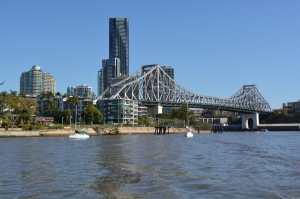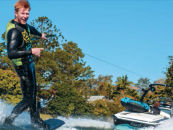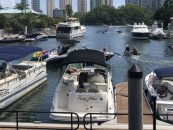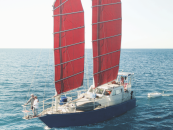A journey along Southeast Queensland’s largest river, the Brisbane River, should be on every boatie’s bucket list.
You will be amazed by the sheer width of the river towards the mouth and the volume of commercial boating traffic—cargo ships, passenger cruise ships, naval war ships, tug boats, barges, trawlers, paddle steamers, CityCats, and cross river ferries—and the hundreds of recreational craft including yachts, cruisers, rowing skulls and sailing dinghies all enjoying the same waterways.
From the mouth of the river to the Gateway Bridge, the river bank is lined with shipping terminals and heavy industry. Further upstream, the river banks become lined with heritage -listed buildings, waterfront mansions, and magnificent parks and gardens. Thirteen nautical miles upstream from the river mouth will see you pass under the Story Bridge, leading you right into the heart of the Brisbane CBD, which is quite spectacular at night.
For most sailing yachts, this will be the end of the journey due to the 12.7m clearance of the Captain Cook Bridge where the South East Freeway passes across the river into the city. For power driven vessels, there are another 30 nautical miles of navigable waterway to explore upstream (dependent upon vessel draught) right up to the city of Ipswich, with sights to see around every bend of the river.
Getting there
It is approximately 45nm from the Gold Coast Seaway to the mouth of the Brisbane River. If travelling by a power boat, at minimum, a 5m runabout is recommended as Moreton Bay regularly serves up 1m+ chop which can be very taxing on both passengers and the vessel itself.
A common route is travelling up the Broadwater, then taking the main channel past Jacobs Well and Cabbage Tree Point, then cruising under the powerlines on the western side of Russel Island. Heading west at Karragarra Island will take you through the “W’s”, through Redland Bay past Coochiemudlo Island and then towards Peel Island. Peel Island is the 30nm mark from the Gold Coast, where most boaties will set anchor for the night before making the 15nm trip to the mouth of the Brisbane River the following morning. The quickest way from Peel Island is to head NW and pass between St Helena and Mud Islands, entering half way along the leads of the Brisbane River at the “Coffee Pots”. At this point you are in the main shipping channel and care must be taken not to impede the safe passage of ships underway.
For trailerable boats, you can skip the 45nm journey by towing your vessel up the M1 and take the Lytton Rd exit, launching at the public Colmslie boat ramp on Col Gardner Drive. Alternatively, there is a public ramp on Fisherman Island at the Port of Brisbane. However, there is a 2.3m bridge clearance should you wish to take the Boat Passage shortcut into the river.
Refuelling locations
There are several on-water fuel facilities available between the Gold Coast Seaway and Brisbane City – namely, Runaway Bay Marina, Horizon Shores Marina (Woongoolba), Rudy Maas Marina (Steiglitz), Raby Bay Marina, Royal Queensland Yacht Squadron (24hr fuel, Manly Boat Harbour), and Rivergate Marina (next to the Gateway Bridge).
Anchorages
Between the Gold Coast Seaway and Victoria Point there are countless places to set anchor for the night. The labyrinth of mangrove islands around Jumpinpin offer excellent protection from winds of just about any strength and direction. Tiger Mullet Channel is one of the most popular anchorages in the Jumpinpin area. Further north, the Bay Islands of Russel, Karragarra, Lamb and Macleay also offer great protection. Coochiemudlo Island provides good protection from northerlies.
Between Victoria Point and the mouth of the Brisbane River, Peel Island is the best anchorage with Horseshoe Bay offering protection from northerlies and Lazaret Gutter offering protection from southerlies. Please note Peel Island should not be approached at night without local knowledge due to the amount of coral in the area. As an alternative anchorage to Peel Island, shelter can also be sought behind Green Island and St Helena Island, but protection can be somewhat limited at times.
On the Brisbane River itself, you should always set anchor close to the river bank so as to not impede any boating traffic. Between the mouth of the River and the Gateway Bridges, the best option is to anchor in Aquarium Passage at Hemmant. Upstream of the Gateway Bridges, vessels generally anchor along the southern bank of the river at Bulimba Point along the Hamilton and Bulimba Reaches, and along the eastern bank of the Town Reach at Kangaroo Point.
Arguably the most scenic anchorage in the Brisbane CBD is the northern bank of the river at Gardens Point, adjacent to the City Botanic Gardens, 200 metres downstream from the Captain Cook Bridge. From here you will have great views of the city skyline, the Kangaroo Point cliffs, and the Story Bridge. There is a floating pontoon managed by the Stamford Plaza at the northern end of the gardens, available for small tenders to tie up temporarily, offering convenient access to the city should you wish to shop for provisions, go shopping in the Queen St Mall, dine in a waterfront restaurant, or simply grab a coffee. It is worthwhile taking a stroll through the magnificent Botanic Gardens before crossing the Goodwill Bridge to visit the Queensland Maritime Museum and Southbank Parklands.
Further upstream from the CBD there are plenty of places to anchor overnight. However, you should always anchor close to the banks of the river and always stay well clear from the ferry terminals.
Dangers
Between Eagle Farm and the mouth of the river, passenger cruise ships and cargo ships operate on a daily basis and often require most of the width of the river to manoeuvre when berthing at their terminals. Massive barges also operate as far as Teneriffe.
CityCat and cross river ferries operate daily between Hamilton and the University of Queensland at St Lucia. A 100m exclusion zone exists around all the ferry terminals, sometimes marked by yellow buoys. If you are approaching an exclusion zone while a CityCat or cross river ferry is approaching or departing the terminal, you must wait until the ferry passes unless you are waved through by the master of the ferry.
Rowing skulls, kayaks, outrigger canoes and small sailing craft operated by school and community groups frequently use the river. You should watch your wash when passing any of these vessels. Rowing skulls are particularly common at dawn and can be difficult to see in low light conditions. Kayaking adventure tours are also operated at night in the river.
Power driven vessels should operate within the centre third of the river, leaving the outside third of the river for passive craft such as rowing skulls and kayaks.
A Brisbane River Code of Conduct has been developed by Maritime Safety Qld, commercial operators and community groups as a guideline to the safe use of the river. It is recommended that you familiarise yourself with this code, which is available on the Maritime Safety Qld website (www.msq.qld.gov.au).
A 15-knot speed limit for all vessels over 8m exists between the Story Bridge and William Jolly Bridge. A 2.5m tidal range in the river causes current up to 4 knots. Early morning fog is common in winter, and debris following heavy rain or flooding can cause a navigational hazard for all craft.
Fishing
Fishing in the Brisbane River between the Gateway Bridge and the mouth can be fantastic, especially for bream, large snapper, mangrove jack, and threadfin salmon. Mulloway are often caught at night under the Gateway Bridge and bridges around the CBD. Bull sharks are a common catch on live mullet all throughout the river system. Fishing tapers off the further upstream you travel, with catfish prevalent in the turbid waters. Further out into Moreton Bay, pelagic fish, such as kingfish and mackerel, can be caught around the “Coffee Pots” on lures, soft plastics and pilchards. Mud Island is also a renowned snapper hotspot, among other reef species, including sweetlips and parrotfish.
By Nic Welch




























